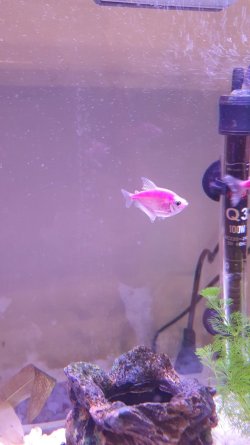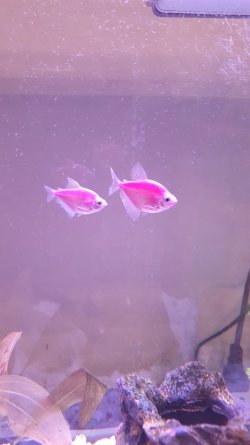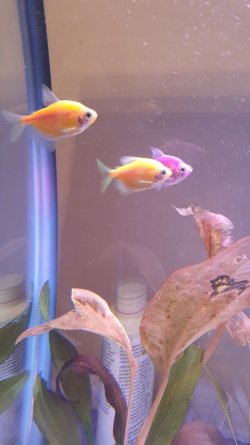Okay thanks. Will do todayThe cream stuff on their fins is excess mucous caused by something in the water irritating the fish. A big water change and gravel cleaning the substrate should get rid of the excess mucous.
You are using an out of date browser. It may not display this or other websites correctly.
You should upgrade or use an alternative browser.
You should upgrade or use an alternative browser.
Help! Ich
- Thread starter Vikasr
- Start date
The April FOTM Contest Poll is open!

🏆 Click to vote! 🏆
TNG
Fish Crazy
Today I see fin rot starting in some fish
You don’t seem to have much luck with your fish. I really think you have a problem with your water.
Are there many aquarists in your local area? It'd be beneficial to see what fish they keep, and if you can share experiences.
Out of the 4 tetras, 3 (2 new ones and 1 older one) look better today. Cant see white spots anywhere on the fish, only some (much reduced) creamy stuff / mucous on their fins. The fish that still does not look good has its fins reduced.
I am still keeping the water temperature above 30C.
I am still keeping the water temperature above 30C.
Doing that. Also did 50% water change and gravel vacuum yesterdayKeep the water clean (make sure it's free of ammonia, nitrite, nitrate) and keep the temperature at or above 30C for 1 week after all the white dots have gone.
The yellow ones are the ones that got ich first. Both look quite fine now.If the fin keeps deteriorating, post a picture of the fish and then add 1 heaped tablespoon of salt per 20 litres (5 gallons) of tank water. Keep salt in there for 2 weeks and see if it helps.
One purple fish has some creamy stuff on its fins and the other one doesnt have that creamy stuff but its fins have reduced quite a lot.
Should I add normal iodised or non iodised salt?
Do I add any salt again or just once? And any salt to be added when I do a water change after 7-8 days?
Thanks for the help.
Attachments
The fins don't look infected. The missing bits look like someone has been biting them, probably the other fish. Black widow/ skirt tetras are renown fin nippers and when stressed they tend to bite more. I would hold off on the salt and see how they look in a week because they don't appear to need treating with salt yet.
---------------------
SALT
Using Salt to Treat Fish Health Issues.
For some fish diseases you can use salt (sodium chloride) to treat the ailment rather than using a chemical based medication. Salt is relatively safe and is regularly used in the aquaculture industry to treat food fish for diseases. Salt has been successfully used to treat minor fungal and bacterial infections, as well as a number of external protozoan infections. Salt alone will not treat whitespot (Ichthyophthirius) or Velvet (Oodinium) but will treat most other types of external protozoan infections in freshwater fishes. Salt can treat early stages of hole in the head disease caused by Hexamita but it needs to be done in conjunction with cleaning up the tank. Salt can also be used to treat anchor worm (Lernaea), fish lice (Argulus), gill flukes (Dactylogyrus), skin flukes (Gyrodactylus), Epistylis, Microsporidian and Spironucleus infections.
You can add rock salt (often sold as aquarium salt), swimming pool salt, or any non iodised salt (sodium chloride) to the aquarium at the dose rate of 1 heaped tablespoon per 20 litres of water. If there is no improvement after 48 hours you can double that dose rate so there is 2 heaped tablespoons of salt per 20 litres.
If you only have livebearers (guppies, platies, swordtails, mollies), goldfish or rainbowfish in the tank you can double that dose rate, so you would add 2 heaped tablespoons per 20 litres and if there is no improvement after 48 hours, then increase it so there is a total of 4 heaped tablespoons of salt per 20 litres.
Keep the salt level like this for at least 2 weeks but no longer than 4 weeks otherwise kidney damage can occur. Kidney damage is more likely to occur in fish from soft water (tetras, Corydoras, angelfish, Bettas & gouramis, loaches) that are exposed to high levels of salt for an extended period of time, and is not an issue with livebearers, rainbowfish or other salt tolerant species.
The salt will not affect the beneficial filter bacteria but the higher dose rate (4 heaped tablespoons per 20 litres) will affect some plants and some snails. The lower dose rate (1-2 heaped tablespoons per 20 litres) will not affect fish, plants, shrimp or snails.
After you use salt and the fish have recovered, you do a 10% water change each day for a week using only fresh water that has been dechlorinated. Then do a 20% water change each day for a week. Then you can do bigger water changes after that. This dilutes the salt out of the tank slowly so it doesn't harm the fish.
If you do water changes while using salt, you need to treat the new water with salt before adding it to the tank. This will keep the salt level stable in the tank and minimise stress on the fish.
When you first add salt, add the salt to a small bucket of tank water and dissolve the salt. Then slowly pour the salt water into the tank near the filter outlet. Add the salt over a couple of minutes.
---------------------
SALT
Using Salt to Treat Fish Health Issues.
For some fish diseases you can use salt (sodium chloride) to treat the ailment rather than using a chemical based medication. Salt is relatively safe and is regularly used in the aquaculture industry to treat food fish for diseases. Salt has been successfully used to treat minor fungal and bacterial infections, as well as a number of external protozoan infections. Salt alone will not treat whitespot (Ichthyophthirius) or Velvet (Oodinium) but will treat most other types of external protozoan infections in freshwater fishes. Salt can treat early stages of hole in the head disease caused by Hexamita but it needs to be done in conjunction with cleaning up the tank. Salt can also be used to treat anchor worm (Lernaea), fish lice (Argulus), gill flukes (Dactylogyrus), skin flukes (Gyrodactylus), Epistylis, Microsporidian and Spironucleus infections.
You can add rock salt (often sold as aquarium salt), swimming pool salt, or any non iodised salt (sodium chloride) to the aquarium at the dose rate of 1 heaped tablespoon per 20 litres of water. If there is no improvement after 48 hours you can double that dose rate so there is 2 heaped tablespoons of salt per 20 litres.
If you only have livebearers (guppies, platies, swordtails, mollies), goldfish or rainbowfish in the tank you can double that dose rate, so you would add 2 heaped tablespoons per 20 litres and if there is no improvement after 48 hours, then increase it so there is a total of 4 heaped tablespoons of salt per 20 litres.
Keep the salt level like this for at least 2 weeks but no longer than 4 weeks otherwise kidney damage can occur. Kidney damage is more likely to occur in fish from soft water (tetras, Corydoras, angelfish, Bettas & gouramis, loaches) that are exposed to high levels of salt for an extended period of time, and is not an issue with livebearers, rainbowfish or other salt tolerant species.
The salt will not affect the beneficial filter bacteria but the higher dose rate (4 heaped tablespoons per 20 litres) will affect some plants and some snails. The lower dose rate (1-2 heaped tablespoons per 20 litres) will not affect fish, plants, shrimp or snails.
After you use salt and the fish have recovered, you do a 10% water change each day for a week using only fresh water that has been dechlorinated. Then do a 20% water change each day for a week. Then you can do bigger water changes after that. This dilutes the salt out of the tank slowly so it doesn't harm the fish.
If you do water changes while using salt, you need to treat the new water with salt before adding it to the tank. This will keep the salt level stable in the tank and minimise stress on the fish.
When you first add salt, add the salt to a small bucket of tank water and dissolve the salt. Then slowly pour the salt water into the tank near the filter outlet. Add the salt over a couple of minutes.
This may very well be true. The other purple fish has been bullying this one and not even letting him eat food. So today I trapped the dominant one in the net and then the other ate. As you suggested, lets wait and watch.The fins don't look infected. The missing bits look like someone has been biting them, probably the other fish. Black widow/ skirt tetras are renown fin nippers and when stressed they tend to bite more.
My fish are surely improving. Its been 10 full days since I first saw the white spots and 8 days since I turned on the heater at 31C.
No white spots / mucous etc can be seen now. The reduced / nipped fin on one tetra has improved considerably.
As suggested, I will keep the heater on for another week or so.
Thanks for all the help
No white spots / mucous etc can be seen now. The reduced / nipped fin on one tetra has improved considerably.
As suggested, I will keep the heater on for another week or so.
Thanks for all the help
Are you saying heat alone without salt for ich? Is it dangerous to use IchX and hi temp at 86F? This is what’s in IchX. Ingredients: water, formaldehyde (<5%), methanol (<2%), malachite green chloride (<0.1%) Recommendations: Use Ich-X to treat conditions related to ich and ich related disease. Caution: Do not use Ich-X with any other medications.Keep the water clean (make sure it's free of ammonia, nitrite, nitrate) and keep the temperature at or above 30C for 1 week after all the white dots have gone.
the IchX directions say nothing about temperature
how quickly can the temperature be safely raised? Like a degree an hour? Would this heat elevation also treat epi?
Last edited:
Are you saying heat alone without salt for ich? Is it dangerous to use IchX and hi temp at 86F? This is what’s in IchX. Ingredients: water, formaldehyde (<5%), methanol (<2%), malachite green chloride (<0.1%) Recommendations: Use Ich-X to treat conditions related to ich and ich related disease. Caution: Do not use Ich-X with any other medications.
the IchX directions say nothing about temperature
how quickly can the temperature be safely raised? Like a degree an hour? Would this heat elevation also treat epi?
I'm fairly sure Colin will agree with me on most if not all of this, and it is something I feel very strongly about so I want to answer your questions.
The safest and most effective while being safe method to "cure" ich is by raising the temperature. There are very very few fish that will have trouble with this, but there are dozens of species (all characins for one thing) that will have serious issues with any chemical or "medication," which in some cases has to be used at such low levels because of this that the effectiveness is questionable. Causing more stress to fish by using such substances only makes it more difficult to deal with issues like ich. More than 90% of all disease that aquarium fish experience is directly due to stress. So keeping stress low is a significant precaution for most health problems.
Formaldehyde and malachite green are very dangerous substances. The latter is carcinogenic (Colin can expand on this) to humans as well as fish. Heat will never cause such issues. And a temperature of 30C/86F will kill the ich in the free swimming stage. One week will achieve this in most cases, but two weeks is generally recommended to make certain. I have done this even with Corydoras which do not like high temperatures, and never lost one. Increase surface disturbance to ensure good oxygen exchange. Nothing else is normally required. Neale Monks suggests that if the ich is especially stubborn, adding salt is safer than the "medications." There is apparently a more resistant strain according to a few members, I've no experience with this. But without any question heat is the safest and most effective while being safe.
Before I installed air conditioning in my former fish room, the air temperature during summer heat waves lasting a week or two hovered around 90F. I never lost a fish. Warm water that is short term is not anywhere near as detrimental as any medication or additive.
As for timing, I do a partial water change to increase the temp in the tank by a couple of degrees, and turn up the heat to achieve the further increase. This has always been done within 24 hours max. After two weeks, I turn the heaters back to normal and let the water naturally cool down. Increased surface disturbance is advisable to ensure a good level of oxygen, as warmer water holds less as you probably know. I also do major water changes (using the warmer temp obviously) during the two weeks, with a serious vacuum of the substrate which can remove the cists waiting there.
Terrific post! Thanks so much, Bryon. Right now I am increasing the temperature. Just to be certain, are you saying simply elevate temp to 86F & no salt? I was just reading about salt levels 1, 2 & 3, each progressively more concentrated. I do have the right aquarium salt. Would the addition of salt harm the fish? I want the minimal effective treatment. No salt suits me fine & I will avoid the IchX the LFS is recommending.
Here’s something that surprised me. I moved the two Emerald Rainbows with the most white spots, 4-8, to another tank & the spots fell off during the transfer. I would have thought the mature protozoan wouldn’t so easily detach. Initially, I thought they were the only two of 15 Rainbows affected, but later noticed 3 or 4 spots on three other fish. I have gone through many old posts here & elsewhere re ich & the white spots sure resemble them.
I can’t yet get pics. These guys are rapid swimmers & small.
I did add an extra air stone.
Here’s something that surprised me. I moved the two Emerald Rainbows with the most white spots, 4-8, to another tank & the spots fell off during the transfer. I would have thought the mature protozoan wouldn’t so easily detach. Initially, I thought they were the only two of 15 Rainbows affected, but later noticed 3 or 4 spots on three other fish. I have gone through many old posts here & elsewhere re ich & the white spots sure resemble them.
I can’t yet get pics. These guys are rapid swimmers & small.
I did add an extra air stone.
Just to be certain, are you saying simply elevate temp to 86F & no salt? I was just reading about salt levels 1, 2 & 3, each progressively more concentrated. I do have the right aquarium salt. Would the addition of salt harm the fish? I want the minimal effective treatment. No salt suits me fine & I will avoid the IchX the LFS is recommending.
Yes to raising the temp but no salt. This is only a second option if needed. And yes, salt does harm fish. Soft water fish are more susceptible than hard water, but salt does negatively impact a fish and unless it is the safest and most effective treatment for "x" do not use it. I have an article on two sites:
Many years ago, 1990's in fact, I killed fish using so-called ich medications because I did not understand the effect these things have on many fish like characins.
I have seen ich spots suddenly disappear, it may be this or something else. I wouldn't worry. The heat is not going to substantially harm these fish.
Healthy fish will not succumb to ich, it only occurs when the fish are stressed. I use a 20g tank permanently running as a quarantine for new fish acquisitions, and more than once I have spotted ich on the new fish, but without doing anything even not increasing heat they fought it off and it never returned. This is one advantage of having a permanently-running QT, it is like an established tank (mine has sand, plants, thick with floating plants, and a couple chunks of bogwood) which means the fish are immediately in a better environment and thus reduced stress.
Latest Discussions
- Replies
- 9
- Views
- 88





